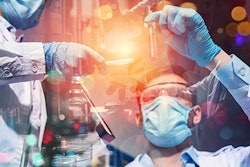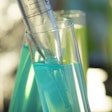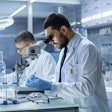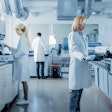
Building testing infrastructure, meeting demand in the global supply chain, and transforming the life sciences through the power of the tech revolution: These are the stories of the early days of the COVID-19 pandemic. Members of the Society for Laboratory Automation and Screening (SLAS) shared their experiences in a February 3 briefing in advance of the organization's annual event.
Imagine being called on in March 2020 -- just as the COVID-19 pandemic started to take shape -- to lead efforts to implement the creation of a national COVID-19 testing infrastructure in your country.
That's what happened to Peter Simpson, chief scientific officer of Medicines Discovery Catapult, who said he was "minding his own business" when he was asked to lead the U.K.'s COVID-19 testing efforts. At the time, the U.K. didn't have the testing infrastructure needed to match the scale of the pandemic, he recalled.
"There was no building. There was no laboratories. There was no automation. There was no assay equipment. There was no people," Simpson explained. "It was a case of begging and borrowing and bartering for everything, because the early days of this pandemic did not suddenly find hundreds of scientists and dozens of tissue cultures who found a whole load of ... liquid handling systems."
The only way to implement such massive testing infrastructure was by collaborating across the public and private sectors in an all-hands-on-deck approach.
"Volunteers from 15 different businesses ... dropped what they were doing and came to work in the facility and for more than a dozen companies," Simpson explained. "We found the one hotel that was still open at Manchester Airport and put up several hundred scientists in the hotel ... we had a shuttle bus from the hotel to the site."
Simpson and his team called in architects and builders and had help from the army and the military to move equipment given by universities around the U.K. They were ready to test in 16 days from the initial day he was asked to lead the effort, Simpson said.
"The scale of the collaboration was unlike anything I've ever seen before," Simpson said. "Medicines Discovery Catapult was at the heart of it. We had fantastic help from all the landlords, companies like AstraZeneca, and universities such as Manchester and Leeds. There were too many people who I could thank in truth to make it happen."
Medicines Discovery Catapult is a not-for-profit organization funded by the U.K. government that connects the scientific and biotech communities together and provides the infrastructure and tools to help the sector succeed.
While Simpson is no longer directly involved in the initial lab facility he implemented, it has now processed more than 20 million samples and has employed 700 people at any one time, and more than 1,000 staff have been trained in how to do diagnostic testing, he noted.
"Hopefully [that's] something that's really helped in the U.K. and leaves a fantastic legacy for the future as well," Simpson said.
Meeting the demand of the global community
When the pandemic hit, Hamilton Storage Technologies, a global supplier of sample preparation, sample processing, and sample access technologies, was challenged to meet global supply needs, recalled Michael Girardi, vice president of sales and marketing at the company.
"We're challenged to continue to support and deploy critical equipment in the COVID research pipeline and had to manage our way through that, and each day was an interesting, unexplored avenue for all of us leading our companies and our teams," Girardi said.
As new labs were raised and testing demand went up, Hamilton had much more demand than supply, Girardi remembered.
"Our equipment, our technologies were needed by new labs, as Peter [Simpson] mentioned," Girardi said. "Demand for all of our products at Hamilton company were requested, and so we had to manage our way and manage [and] allocate product and resources ... carefully. We had much more demand than we had supply."
Hamilton Storage Technologies equipment is deployed at academic research hospitals and large pharmaceutical companies around the world.
'Re-platforming' the life sciences
Early on in the pandemic, many scientists had no choice but to go into the laboratory while other employees worked from home, said Simon Meffan-Main, PhD, the vice president of product at Tetra Partner Network.
"Scientists were actually being forced to ... the laboratory because a lot of the existing technologies in the labs couldn't be running remotely," Meffan-Main said. "You know, it was still workstation-based, or maybe it was enterprise class-based, but [there were] very little cloud-based technologies in the laboratory."
At the start of the pandemic, Meffan-Main was responsible for software engineering at Waters, where he moved 450 employees across three continents to remote work. When he left Waters, he went to work for Tetra, which is focused on cloud-based operations and removing data silos in the life sciences to allow data to flow freely across laboratories, he said.
For Meffan-Main and others, the life sciences industry was already re-platforming before COVID-19, but the pandemic compressed the process. Speaking with a person from a top pharmaceutical company at the start of the pandemic, Meffan-Main said he will never forget what that conversation meant for the life sciences industry.
"They said, 'We had a plan for digital transformation that was going right over the next five years. We are now compressing that plan into the next 18 months,'" he recalled. "I think that's now the wave that Tetra Science is riding. We're seeing this increasing need to make data available for anyone and to create an open ecosystem that crosses the vendor divides."
Now, the primary focus of the biotech and pharmaceutical industry will be this digitization wave, he said.
"This wave of digital transformation and the wave of automation ... is now going to be the primary focus post-pandemic for the entire biotech and pharma industry," Meffan-Main concluded.



















